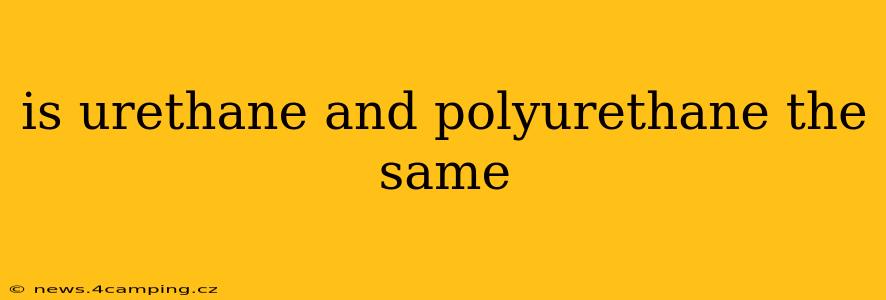Is Urethane and Polyurethane the Same? Understanding the Relationship
The short answer is: no, urethane and polyurethane aren't exactly the same, but they are very closely related. The confusion stems from the chemical makeup and common usage of the terms. Let's delve deeper into the specifics to clarify the difference.
Urethane is actually a chemical group—a specific type of chemical bond—while polyurethane is a polymer made from that chemical group. Think of it like this: "urethane" is like the building block, and "polyurethane" is the house built from those blocks.
Urethane (Carbamate): The Building Block
Chemically, urethane refers to a functional group with the formula -NH-COO-. This group is characterized by a carbamate linkage, which is formed by the reaction of an isocyanate (-N=C=O) with an alcohol (-OH). This reaction is crucial to the creation of polyurethanes.
Polyurethane: The Polymer Family
Polyurethane is a large family of polymers (long chains of repeating molecules) that contain the urethane group (-NH-COO-) within their molecular structure. The properties of polyurethane vary widely depending on the specific types of isocyanates and alcohols used in its production. This allows for the creation of a vast array of materials with diverse characteristics.
What are the Different Types of Polyurethane?
The versatility of polyurethane is immense, leading to a wide range of applications. Different types of polyurethanes are created by varying the isocyanate and alcohol components in the chemical reaction. Some examples include:
- Rigid Polyurethane Foam: Used in insulation, refrigeration, and packaging due to its excellent thermal insulation properties.
- Flexible Polyurethane Foam: Common in furniture cushioning, mattresses, and automotive interiors due to its softness and comfort.
- Polyurethane Elastomers: These are durable and stretchy materials used in things like shoe soles, belts, and hoses.
- Polyurethane Coatings: Used to protect surfaces from abrasion, corrosion, and chemicals. These coatings can be found on floors, automobiles, and appliances.
- Polyurethane Adhesives: These are strong and versatile adhesives used in a wide range of applications.
What are the key differences between polyurethane and urethane?
- Scale: Urethane is a functional group (a small part of a molecule), while polyurethane is a large polymer (a long chain of molecules).
- Properties: Urethane itself doesn't have specific properties. The properties of polyurethane are highly variable and depend on its chemical composition.
- Application: You won't find "urethane" as a material sold on its own. Polyurethane, however, is sold as a wide range of products with different applications.
How are Polyurethane and Urethane Used in Everyday Life?
You encounter polyurethane in many aspects of daily life, often without even realizing it. Think about:
- Mattresses and pillows: Many comfortable bedding products use flexible polyurethane foam.
- Furniture: Cushions and padding in furniture often incorporate polyurethane.
- Clothing: Polyurethane coatings are used on some fabrics to make them waterproof or stain-resistant.
- Insulation: Rigid polyurethane foam is a popular choice for thermal insulation in buildings and appliances.
Is there any overlap in the terminology?
While technically distinct, the terms are often used interchangeably in casual conversation, leading to the confusion. However, in technical contexts, the distinction between the urethane group and the polyurethane polymer is crucial.
In summary, while the terms are closely related, understanding the difference between the chemical building block (urethane) and the resulting polymer family (polyurethane) is vital for accurate comprehension of material science and industrial applications.
